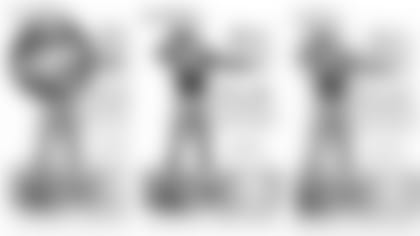Ike from Fargo, ND
How much stock have you put into post-draft grades over the years?
Let me answer this way. When people ask me my age now, I tell them I'm three years on the downside of life expectancy. It took a while, but one of the things I've learned over my adult life is that the smartest people I encounter are those who know what they don't know.
Generally, those who fall into that category also tend to share knowledge rather than spout worthless opinions.
That's one of the reasons I watched the NFL Draft on the NFL Network this year rather than ESPN. Daniel Jeremiah, a former college quarterback and NFL scout; Joel Klatt, another former college quarterback who signed a free agent deal with New Orleans; and Charlie Davis, a former college defensive back and assistant coach, focused on offering a summary of each pick's strengths and weaknesses instead of sounding off like they know more than the personnel people who just made the pick.
Also, fresh in my memory, was ESPN's instant assessment of the 2023 draft.
Mel Kiper's list of the five teams with the most head-scratching drafts last year was headed by Detroit. Also on the list was Houston.
Here was what Kiper had to say about Detroit's selections:
"I thought I would like the Lions' class when they traded down at six. … But I just don't get these two choices. Let's start with (Jahmyr) Gibbs, a multi-dimensional player who racked up receptions for the Crimson Tide. Look who else was on the board at 12, though. One of the cornerbacks, Christian Gonzales or Emanuel Forbes or Deonte Banks; or edge rusher Nolan Smith made more sense to me. Yes, Detroit had a bunch more picks on day two, but it could have found a running back there instead of 12.
"As for (Jack) Campbell, it's a reach 40 spots in my rankings. He's the third-ranked inside linebacker. I thought he'd go in the middle of round two. Instead, when we talk positional value, both of these positions are not generally prioritized in the first round, so this is the very definition of head-scratching."
This was Kiper's offering on the Texans' selections:
"In a vacuum, I love the prospects they added. Yes, (C.J.) Stroud is my third-ranked passer, but I had him at No. 5 overall on my Big Board – he was just behind Will Levis in my position rankings. (Will) Anderson had outstanding sack production in college and could rack up 10 sacks per season. The reason I wrote 'in a vacuum' there is because of the haul Houston had to send to move up. This is a roster that needs a ton of help, so are we sure that the 2024 first-rounder won't end up in the top five again? Houston no longer has a second-round pick in this draft."
If you went to a stockbroker with a spare $10,000 to invest and got that kind of results would you turn to that person again the next year with another $10,000?
Based on rookie returns, the Texans and Lions certainly had two of the best drafts last year. In fact, I'd argue they had the two best based on their overall improvement as a team and how much of it could be attributed to their draft picks. The Texans shot up from a 3-13-1 to a 10-7 finish and a division title. The Lions leaped from 9-8 to 12-5 and also a division championship.
Stroud and Anderson were the Offensive and Defensive rookies of the year, respectively.
Gibbs and the Lions' second-round pick, tight end Sam LaPorta, were two of the other six rookie of the year finalists. Next to quarterbacks, playmakers determine the winner of most NFL games, and Gibbs finished with 1,261 total yards and 11 TDs. With his 10 TDs and 86 receptions, LaPorta arguably rivaled Travis Kelce for being the best playmaking tight end in the league last season.
As for Campbell, he wasn't a splashy defender but he added some much-needed punch to Detroit's defense, although its second-round defensive choice Brian Branch was more of a playmaker.
Also, in Kiper's worst five were the Green Bay Packers, whose draft yielded more than a half-dozen key contributors on another of the league's most improved teams.
Kiper and his ESPN cohorts weren't alone in bashing Detroit's draft last year. Remember these headlines last spring?
The Sporting News, by Jacob Camenker: "The 15 worst value picks in the 2023 NFL Draft. From Lions' Jahmyr Gibbs to 49ers' Jake Moody"
USA TODAY, by Michael Middlehurst-Schwartz: "NFL drafts most questionable first-round picks: Lions double-dip with bewildering choices" The writer then listed Gibbs, No. 1; and Campbell, No. 2, as the two worst choices of the first round.
Slate, by Alex Kirshner: "The Lions Made the Weirdest Pick of the NFL Draft: Jahmyr Gibbs is an incredible athlete. But taking him so high strains belief."
Pro Football Focus, by Max Chadwick: "2023 NFL Draft: The four biggest reaches of Round 1, including Jahmyr Gibbs and Jack Campbell to the Detroit Lions"
PFF didn't like the Lions draft because Gibbs and Campbell weren't on its list of first-round prospects. The two other drafts it didn't like were Green Bay's because it didn't take a receiver in the first round, and Houston's because it traded away its 2024 No. 1 because it might cost the Texans QB Caleb Williams."
How much does that website charge, again, for that kind of brilliant insight?
Sorry for not directly answering your question yet. But how much stock do I put into post-draft grades? Absolutely none. What's more, I find it incredulous that any pundit, any fan or any website that claims to do a deep dive into studying film of college prospects would think they might know more than the personnel people involved in the selection process at the draft headquarters of each NFL team.
Nate from Manitowoc, WI
What do you see as the most important draft classes in Packers history?
In my mind, quality matters more than quantity in evaluating drafts.
Hence, I'd start with the 1958 draft that produced three Pro Football Hall of Famers: Jim Taylor, Ray Nitschke and Jerry Kramer. In addition, first-round pick Dan Currie, a linebacker from Michigan State, was selected to a first-team all-pro team in three of his first six seasons and was widely viewed as a better pick than Nitschke until he injured his knee in 1962 and was never the same. Guard Ken Gray, the Packers' sixth round choice, was cut in camp by Scooter McLean and played in six Pro Bowls for the Chicago/St. Louis Cardinals.
The 1956 draft included two Hall of Famers, Forrest Gregg and Bart Starr, plus two captains during the Lombardi era, Bob Skoronski and Hank Gremminger.
I think those would be the two best Packers' drafts, and coach Lisle Blackbourn oversaw both of them with assistance from talent scout Jack Vainisi.
Moreover, Blackbourn called the shots in 1957 when the Packers selected Paul Hornung, maybe their best No. 1 choice of all-time; Ron Kramer, who might have been another Pro Football Hall of Famer if not for a severe leg injury as a rookie and an abbreviated career in Green Bay when he played out his option in 1964. Also, hard-nosed safety John Symank was a 23rd-round selection that year.
Blackbourn's 1958 draft might be rivaled only by Pittsburgh's 1974 choices for the best ever. And Blackbourn's three-year run of drafts from 1956-58 might be matched only by the Chicago Bears from 1939-41 and Pittsburgh from 1969-71.
The first draft was held in 1936 and Curly Lambeau's two best drafts in 1938 (Cecil Isbell, Andy Uram and Pete Tinsley) and 1939 (Charley Brock and Larry Craig) played a big part in him winning his final NFL championships in 1939 and '44.
Gene Ronzani's 1952 draft, also with Vainisi playing a behind-the-scenes role, would certainly rank high on the Packers' all-time list with four Packers Hall of Famers: Billy Howton, Bobby Dillon, Dave Hanner and Deral Teteak.
Next to Hornung, the Packers' best-ever No.1s pre-Ron Wolf era might have been Herb Adderley in 1961 and Dave Robinson in 1963, when Vince Lombardi made the picks.
In the lean years from 1968-91, the two drafts that stick in my mind were 1972, when Willie Buchanon and Chester Marcol, two of the top three choices, were instrumental in the Packers winning their only division title during that stretch, although neither player passed the longevity test. And the other would be 1978 with James Lofton, John Anderson, Mike Douglass, Leotis Harris and Terry Jones. Lofton would be in the same company as Adderley and Robinson as No. 1 choices.
As for Ron Wolf's best draft, it was probably 1995 with Craig Newsome, William Henderson, Brian Williams, Antonio Freeman and Adam Timmerman. But I think 2000 was a close second with Bubba Franks, Chad Clifton, Na'il Diggs, Kabeer Gbaja-Biamila and Mark Tauscher. And the 1992 draft would be in the running, as well: Robert Brooks, Edgar Bennett and Mark Chmura.
The key to Wolf's drafts were the depth of them.
No question, I think Ted Thompson's best draft was his first, 2005. When a team drafts a Pro Football Hall of Fame quarterback (Aaron Rodgers) that's a bonanza in itself. Plus, Nick Collins was a three-time Pro Bowl selection in his first six seasons.
As for Brian Gutekunst's drafts, the Packers will take roughly 20 picks from their 2022 and '23 selections to training camp this year and most of them will likely start or play important situational roles on what could be a title contender. While the jury is still out on those drafts, those are some striking numbers. Plus, I'll reserve judgment on Gutekunst's 2020 draft, but one player (Jordan Love) could make that a special draft.
Bill from Bloomfield Hills, MI
In all the discussion regarding Green Bay's history of drafting QBs, it has been said they never drafted a QB as the No. 1 overall pick. Hornung was a QB his senior year at Notre Dame. Was there any consideration at the time for him as a prospect to play QB in the NFL – by the Packers or other teams?
Actually, the Packers have had the No. 1 overall pick in only two of the 89 NFL drafts and both times they selected a quarterback: Hornung in 1957 and Randy Duncan in 1959. Hornung was a two-year starter at quarterback for Notre Dame and listed as a quarterback in the Green Bay Packers 1957 Press, Radio and TV Guide. In the 1957 NFL Record and Rules Manual's list of draft picks, all backs were listed merely as "B," including quarterbacks.
Thus, I don't know why today's NFL Record & Fact Book and Packers media guide list Hornung as a halfback in their draft sections. Other players are listed at their college position or projected pro position, not where they eventually wound up playing in the pros.
As for Hornung, when he was drafted on Nov. 26, 1956, the lead on the Associated Press draft story read: "The Green Bay Packers selected Notre Dame Quarterback Paul Hornung as their NFL bonus choice…"
When the College All-Stars gathered in Chicago on July 18, 1957, to prepare for their game against the defending league champion New York Giants, Hornung was listed on the roster as one of four quarterbacks. The others were fellow No. 1 draft picks John Brodie and Len Dawson, along with Jimmy Harris, a fifth-round choice by Philadelphia who played defensive back in the pros.
The All-Stars lost, 22-12, and their coach, Curly Lambeau, started Brodie at quarterback, but Hornung started the second half, finishing with five completions in seven attempts for 39 yards. And when Hornung reported to the Packers' training camp in Stevens Point following the game, he started out practicing at quarterback and also playing there in his first preseason game.
That said, the day of the draft, Blackbourn had said Hornung's versatility was a big factor in their decision to choose him. Blackbourn also worked Hornung at fullback and left halfback in camp, and he played fullback during his rookie season.
But early in that season, Blackbourn was still hoping to make a quarterback out of Hornung. In the fourth game, a 24-14 loss to San Francisco, Hornung saw his first extended action, when he went in at quarterback in the fourth quarter. He drove the Packers 59 yards in seven plays, including a 37-yard run off tackle and a 9-yard keeper for a touchdown with 58 seconds to play.
When meeting with reporters after the game, Blackbourn said, "(Hornung) ran that draw play beautifully, and he also ran well when he was trapped attempting to pass. Now we've just got to get him to throw. If we can, he's our quarterback – he's got to be." 49ers coach Frankie Albert also praised Hornung in his postgame comments, saying, "He's a man of many talents."
But the following week for whatever reason, Blackbourn started Hornung at fullback, and he led the team in rushing with 33 yards in seven attempts, a 4.7 average, and scored two touchdowns as the Packers upset the Baltimore Colts, 24-21. Hornung started again at fullback the next week and rushed for 112 yards in 16 attempts, a 7-yard average, in a loss to the New York Giants.
It looked like Hornung had found a home.
In his first four games as a starter, he rushed for 239 yards in 46 carries, a 5.2 average. But then he suffered what was described as a badly sprained ankle in the first quarter of his fifth start, gained only two yards, and didn't have a single rushing attempt in the final three games. Total Football, the NFL's official encyclopedia, and other sources credit Hornung for playing in all 12 games that season, but he didn't play on Thanksgiving against Detroit. He played in only 11 games and was relegated to little more than kicking off in the final three.
Mike from Stevens Point, WI
Looking back at the contributions of the 2023 Packers' draft class, how rare is it to have 10 picks play in a game? Has this ever happened before the NFL?
Actually, 11 of last year's draft picks appeared in a game. That was the most ever Packers' choices who played in a game in their first eligible season. The previous record was 10 in both 2006 and 2022.
The 2006 class included A.J. Hawk, Daryn Colledge, Greg Jennings, Abdul Hodge, Jason Spitz, Will Blackmon, Ingle Martin, Tony Moll, Johnny Jolly and Tyrone Culver. And the number could have been 11 except that the Packers waived their last pick, defensive end Dave Tollefson, and he wound up winning two Super Bowl rings with the New York Giants and playing in 78 NFL regular-season games.
Anybody know what the league record is for most draft picks to play in at least one game in their first eligible NFL season?















